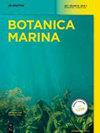利用 DNA 测序对厄瓜多尔加拉帕戈斯群岛的叶片形成莼(叶绿体)物种进行分类评估
IF 1.4
4区 生物学
Q2 MARINE & FRESHWATER BIOLOGY
引用次数: 0
摘要
DNA 序列来自 2018 年和 2019 年从加拉帕戈斯群岛的四个岛屿采集的 32 个叶片莼标本:费尔南迪纳岛、弗洛雷纳岛、伊莎贝拉岛和圣克里斯托瓦尔岛。测序的位点是核编码的 ITS 和质体编码的 rbcL 和 tufA,它们都是公认的绿藻条形码标记。发现了四个物种,分别是 adhaerens 莼菜、lactuca 莼菜、ohnoi 莼菜和 tanneri 莼菜,所有这些物种的模式标本都已测序,确保了这些名称的正确应用。其中只有乳莼(U. lactuca)在历史上被报道来自该群岛。莼菜(Ulva adhaerens)是最常采集到的物种,分布广泛,在所有四个岛屿上都有分布。adhaerens 的首次报告。Ulva ohnoi 在伊莎贝拉岛、弗洛雷阿纳岛和圣克里斯托瓦尔岛这三个岛上被采集到,而 Ulva lactuca 只在后两个岛上被采集到。莼菜(Ulva tanneri)是一种矮小、1-2 厘米高的潮间带物种,很容易被忽视,但很可能比采集到的一个标本更为常见。这项关于叶片形成莼菜物种的研究证实,我们需要共同努力,利用 DNA 测序来记录加拉帕戈斯群岛的海藻群。本文章由计算机程序翻译,如有差异,请以英文原文为准。
Taxonomic assessment of blade-forming Ulva species (Ulvales, Chlorophyta) in the Galápagos Archipelago, Ecuador using DNA sequencing
DNA sequences were obtained from 32 blade-forming Ulva specimens collected in 2018 and 2019 from four islands in the Galápagos Archipelago: Fernandina, Floreana, Isabela and San Cristóbal. The loci sequenced were nuclear encoded ITS and plastid encoded rbc L and tuf A, all recognized as barcode markers for green algae. Four species were found, Ulva adhaerens , U. lactuca , U. ohnoi and U. tanneri , all of which have had their type specimens sequenced, ensuring the correct application of these names. Only one of these, U. lactuca , was reported historically from the archipelago. Ulva adhaerens was the species most commonly collected and widely distributed, occurring on all four islands. Previously known only from Japan and Korea, this is the first report of U. adhaerens from the southeast Pacific Ocean. Ulva ohnoi was collected on three islands, Isabela, Floreana, and San Cristóbal, and U. lactuca only on the last two. Ulva tanneri is a diminutive, 1–2 cm tall, high intertidal species that is easily overlooked, but likely far more common than the one specimen that was collected. This study of blade-forming Ulva species confirms that a concerted effort, using DNA sequencing, is needed to document the seaweed flora of the Galápagos Archipelago.
求助全文
通过发布文献求助,成功后即可免费获取论文全文。
去求助
来源期刊

Botanica Marina
生物-海洋与淡水生物学
CiteScore
4.10
自引率
4.50%
发文量
43
期刊介绍:
Botanica Marina publishes high-quality contributions from all of the disciplines of marine botany at all levels of biological organisation from subcellular to ecosystem: chemistry and applications, genomics, physiology and ecology, phylogeny and biogeography. Research involving global or interdisciplinary interest is especially welcome. Applied science papers are appreciated, particularly when they illustrate the application of emerging conceptual issues or promote developing technologies. The journal invites state-of-the art reviews dealing with recent developments in marine botany.
 求助内容:
求助内容: 应助结果提醒方式:
应助结果提醒方式:


